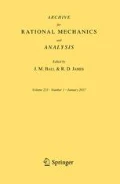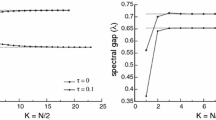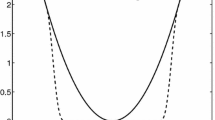Abstract
We apply Gamma calculus to the hypoelliptic and non-symmetric setting of Langevin dynamics under general conditions on the potential. This extension allows us to provide explicit estimates on the convergence rate (which is exponential) to equilibrium for the dynamics in a weighted \(H^1(\mu )\) sense, \(\mu \) denoting the unique invariant probability measure of the system. The general result holds for singular potentials, such as the well-known Lennard–Jones interaction and confining well, and it is applied in such a case to estimate the rate of convergence when the number of particles N in the system is large.
Similar content being viewed by others
References
Athreya, A., Kolba, T., Mattingly, J.C.: Propagating Lyapunov functions to prove noise-induced stabilization. Electron. J. Probab. 17(96), 38, 2012
Bakry, D., Cattiaux, P., Guillin, A.: Rate of convergence for ergodic continuous Markov processes: Lyapunov versus Poincaré. J. Funct. Anal. 254(3), 727–759, 2008
Baudoin, F.: Bakry-émery meet Villani. J. Funct. Anal. 273(7), 2275–2291, 2017
Cattiaux, P., Guillin, A., Monmarché, P., Zhang, C.: Entropic multipliers method for Langevin diffusion and weighted log sobolev inequalities, arXiv preprint arXiv:1708.01058 (2017)
Conrad, F., Grothaus, M.: Construction, ergodicity and rate of convergence of \(N\)-particle Langevin dynamics with singular potentials. J. Evol. Equ. 10(3), 623–662, 2010
Cooke, B., Herzog, D.P., Mattingly, J.C., McKinley, S.A., Schmidler, S.C.: Geometric ergodicity of two-dimensional Hamiltonian systems with a Lennard–Jones-like repulsive potential. Commun. Math. Sci. 15(7), 1987–2025, 2017
Dolbeault, J., Mouhot, C., Schmeiser, C.: Hypocoercivity for linear kinetic equations conserving mass. Trans. Am. Math. Soc. 367(6), 3807–3828, 2015
Eberle, A., Guillin, A., Zimmer, R.: Couplings and quantitative contraction rates for Langevin dynamics. Ann. Probab. 47(4), 1982–2010, 2019
Eberle, A., Guillin, A., Zimmer, R.: Quantitative Harris-type theorems for diffusions and McKean–Vlasov processes. Trans. Am. Math. Soc. 371(10), 7135–7173, 2019
Grothaus, M., Stilgenbauer, P.: A hypocoercivity related ergodicity method for singularly distorted non-symmetric diffusions. Integral Equ. Oper. Theory 83(3), 331–379, 2015
Hairer, M., Mattingly, J.C.: Spectral gaps in Wasserstein distances and the 2D stochastic Navier–Stokes equations. Ann. Probab. 36(6), 2050–2091, 2008
Hairer, M., Mattingly, J.C.: Slow energy dissipation in anharmonic oscillator chains. Commun. Pure Appl. Math. 62(8), 999–1032, 2009
Hairer, M., Mattingly, J.C.: Yet another look at Harris’ ergodic theorem for Markov chains, Seminar on Stochastic Analysis, Random Fields and Applications VI, Progr. Probab., vol. 63, Birkhäuser/Springer Basel AG, Basel, 2011, pp. 109–117.
Hérau, F., Nier, F.: Isotropic hypoellipticity and trend to equilibrium for the Fokker–Planck equation with a high-degree potential. Arch. Ration. Mech. Anal. 171(2), 151–218, 2004
Herzog, D.P., Mattingly, J.C.: Noise-induced stabilization of planar flows I. Electron. J. Probab. 20(111), 1–43, 2015
Herzog, D.P., Mattingly, J.C.: Ergodicity and Lyapunov functions for Langevin dynamics with singular potentials, arXiv preprint arXiv:1711.02250 (2017)
Hörmander, L.: Hypoelliptic second order differential equations. Acta Math. 119, 147–171, 1967
Iacobucci, A., Olla, S., Stoltz, G.: Convergence rates for nonequilibrium Langevin dynamics. Ann. Math. Qué. 43(1), 73–98, 2019
Khasminskii, R.: Stochastic stability of differential equations, second edn., Stochastic Modelling and Applied Probability, vol. 66, Springer, Heidelberg, With contributions by G. N. Milstein and M. B, Nevelson (2012)
Katriel, G.: Mountain pass theorems and global homeomorphism theorems. Ann. Inst. H. Poincaré Anal. Non Linéaire 11(2), 189–209, 1994
Lu, Y., Mattingly, J.C.: Geometric ergodicity of Langevin dynamics with Coulomb interactions, arXiv preprint arXiv:1902.00602 (2019)
Mattingly, J.C., Stuart, A.M., Higham, D.J.: Ergodicity for SDEs and approximations: locally Lipschitz vector fields and degenerate noise. Stoch. Process. Appl. 101(2), 185–232, 2002
Meyn, S.P., Tweedie, R.L.: Stability of Markovian processes. III. Foster–Lyapunov criteria for continuous-time processes. Adv. Appl. Probab. 25(3), 518–548, 1993
Monmarché, P.: On \({mathcal H }^1\) and entropic convergence for contractive PDMP. Electron. J. Probab. 20(128), 30, 2015
Monmarché, P.: Generalized \(\Gamma \) calculus and application to interacting particles on a graph. Potential Anal. 50(3), 439–466, 2019
Rey-Bellet, L.: Ergodic Properties of Markov Processes, Open Quantum Systems. II, Lecture Notes in Mathematics, vol. 1881. Springer, Berlin 2006
Talay, D.: Stochastic Hamiltonian systems: exponential convergence to the invariant measure, and discretization by the implicit Euler scheme. Markov Process. Related Fields 8(2), 163–198, 2002. 163–198, Inhomogeneous random systems (Cergy-Pontoise, 2001)
Tropper, M.M.: Ergodic and quasideterministic properties of finite-dimensional stochastic systems. J. Statist. Phys. 17(6), 491–509, 1977
Villani, C.: Hypocoercivity. Mem. Am. Math. Soc. 202(950), iv+141, 2009
Zimmer, R.: Couplings and Kantorovich contractions with explicit rates for diffusions, Ph.D. thesis, Universitäts-und Landesbibliothek Bonn (2017)
Author information
Authors and Affiliations
Corresponding author
Additional information
Communicated by C. Mouhot
Publisher's Note
Springer Nature remains neutral with regard to jurisdictional claims in published maps and institutional affiliations.
Fabrice Baudoin: Research was supported in part by the Simons Foundation and NSF Grant DMS-1901315.
Maria Gordina: Research was supported in part by NSF Grants DMS-1712427 and DMS-1954264.
David P. Herzog: Research was supported in part by NSF Grants DMS-1612898 and DMS-1855504.
Appendix
Appendix
Here we provide details behind some of the more technical estimates in the paper.
1.1 Quantitative Inequalities for \(\mu \)
Recall that \(\mu \) denotes the product Gibbs measure (2.13), and let \(\mu _1\) and \(\mu _2\) denote the marginal measures given by
defined for Borel subsets \(A\subseteq ({\mathbf {R}}^k)^N\) and \(B\subseteq {\mathscr {O}}\).
Proposition 5.9
Suppose that U satisfies Assumptions 2.6 and 2.7 and recall the constant \(R_2>0\) defined in the statement of Theorem 5.1. Then we have
Moreover, if \(K\subseteq {\mathscr {X}}\) denotes the set in Theorem 5.1, then
Proof
Suppose that \(U:({\mathbf {R}}^k)^N\rightarrow [0, \infty ]\) satisfies Assumptions 2.6 and 2.7. Consider the following gradient system on \({\mathscr {O}}\)
where W(t) is a standard, Nk-dimensional Brownian motion on \((\Omega , {\mathscr {F}}, {\mathbf {P}})\). Under the assumptions on the potential U, it is not hard to show that, like Equation 2.1, Equation (5.11) has unique pathwise solutions on the state space \({\mathscr {O}}\) for all finite times \(t\geqslant 0\). Moreover, \(\mu _2\) is the unique invariant probability measure for the Markov process X(t). This can be seen by using U itself as a Lyapunov functional employing the hypotheses of the statement. For \(n\in {\mathbf {N}}\), let \(\xi _n\) be the first exit time of the process (5.11) from the set \(\{ U \leqslant n \}\) and observe that
Next, to bound the quantity above, note that \(|\Delta U | \leqslant \sqrt{d} \sup _{|y|\leqq 1} |\nabla ^2 U y|\). Hence applying Assumption 2.7 gives
Since \(U\geqslant 0\) and \(\kappa ' \in (0,1)\), this then implies the estimate
Using Fatou’s lemma and the fact that \(\xi _n\rightarrow \infty \) almost surely, we find that for all \(t>0\)
Thus, by another simple approximation argument using convergence of the Césaro means to \(\mu _2\),
This gives the first inequality.
For the second, observe that if \(f(R)= c_\infty R^{2-\frac{2}{\eta _\infty }} - d_\infty \), then
Hence, employing the first inequality
from which we arrive at the second claimed bound by plugging in \(R=R_2\).
To obtain the final desired inequality, observe that
Now, to get a bound on the remaining quantity above, this time we consider the process V(t) on \(({\mathbf {R}}^k)^N\) defined by
where W(t) is a standard Brownian motion on \(({\mathbf {R}}^k)^N\) on \((\Omega , {\mathscr {F}}, {\mathbf {P}})\). Note that this process is exactly in the same form as in (5.11) by setting \(U(v)= |v|^2/2\). Hence, in exactly the same way as before, it follows that
for all \(t>0\). Consequently,
Plugging this fact into the above gives
\(\square \)
1.2 Quantitative Bounds for Singular Potentials
Next we aim to prove Proposition 2.40 which gives the claimed estimates on the singular potential in Example 2.37. We first need the following lower bound on the gradient:
Lemma 5.12
Consider the potential U and the open set \({\mathscr {O}}\) defined in Example 2.37. Then we have the estimate
for all \(x\in {\mathscr {O}}\).
The argument is a reworking of the proof of Lemma 4.12 of [5]. This proof is also in [16], but here we give explicit constants.
Proof
The idea behind the proof is to use the basic fact that, for \(x\in {\mathscr {O}}\), \(|\nabla U (x)| \geqslant |\nabla U(x) \cdot y|\) for all \(y\in ({\mathbf {R}}^k)^N\) with \(|y|=1\). Then we aim to pick a convenient direction \(y\in ({\mathbf {R}}^k)^N\) with \(|y|=1\). Notationally, we set \({\mathscr {Z}}_N= \{ 1, 2, \ldots , N\}\).
We first claim that
for all \(i=1,2, \ldots , N\) and \(x\in {\mathscr {O}}\). From this, summing both sides of the previous inequality from 1 to N it follows that
on \({\mathscr {O}}\). Note that without loss of generality it suffices to show the bound (5.14) above for \(i=1\) and for \(|x_1| > 1\). For \(x=(x_1, x_2, \ldots , x_N)\in {\mathscr {O}}\), consider an increasing sequence of sets \(S_i(x)\), \(i=1,2, \ldots , N\), defined inductively as follows:
Observe that \(S_1(x)\ne \emptyset \) since \(1\in S_1(x)\). Also note that for any \(i,j \in S_N(x)\), \(|x_i - x_j| < 1\). Consequently, combining \(|x_1-x_j|^2=|x_1|^2+ |x_j|^2 - 2 x_1\cdot x_j\) with the inequality \(|x_1-x_j|<1\), it follows that for \(j\in S_N(x)\), \(2 x_1 \cdot x_j \geqslant |x_1|^2 + |x_j|^2 - 1 \geqslant 0\) where the last inequality follows since \(|x_1|>1\). Moreover, if \(i\in S_N(x)\) while \(j\notin S_N(x)\) we have that \(|x_i - x_j | \geqslant N^{-1}\). Let \(\sigma (x)=(\sigma _1(x), \ldots , \sigma _N (x)) \in ({\mathbf {R}}^k)^N\) be such that \(\sigma _i(x)= x_1/|x_1|\) if \(i\in S_N(x)\) and \(\sigma _i=0\) otherwise. We thus have the bound
Next note that
Consequently,
Plugging this back into (5.16), we obtain the following inequality
This finishes the proof of the bound (5.14) when \(i=1\), as desired.
We next show that for all \(i,m \in {\mathscr {Z}}_N\) with \(i\ne m\)
for all \(x =(x_1, x_2, \ldots , x_N) \in {\mathscr {O}}\). Note then that this estimate together with the bound (5.15) implies the lemma. Without loss of generality, we will prove the bound (5.17) for \(i=1, m=2\). For \(x\in {\mathscr {O}}\), let \(\sigma (x)= (x_2-x_1)/|x_2-x_1|\) and \(\xi _k(x)= c_k(x) \sigma (x)\) where the constants \(c_k(x) \in \{-1,1\}\) are chosen to satisfy \(c_k(x) = 1\) if \(x_k\cdot \sigma (x) < x_2 \cdot \sigma (x)\) and \(c_k(x)=-1\) otherwise. With this choice of direction \(\xi (x):=(\xi _1(x), \ldots , \xi _N(x))\) we find that on \({\mathscr {O}}\):
To bound the remaining term on the righthand side above, note that if i, n are either such that \(x_i \cdot \sigma (x) < x_2(x) \cdot \sigma (x)\) and \(x_n \cdot \sigma (x) < x_2\cdot \sigma (x)\) or such that \(x_i \cdot \sigma (x) \geqslant x_2 \cdot \sigma (x)\) and \(x_n \cdot \sigma (x) \geqslant x_2 \cdot \sigma (x)\), then \(c_i(x)=c_n(x)\). Hence the corresponding term in the sum in (5.18) is zero. On the other hand, if i, n are either such that \(x_i\cdot \sigma < x_2 \cdot \sigma \leqslant x_n \cdot \sigma \) or such that \(x_n \cdot \sigma < x_2\cdot \sigma \leqslant x_i \cdot \sigma \), then the corresponding term in the sum (5.18) is nonnegative via the \(c_i(x)\), \(c_n(x)\). In particular, by these observations we arrive at the estimate
as \(c_1(x)-c_2(x) =2\) and \((x_2-x_1)\cdot \sigma = |x_2-x_1|\) by construction. \(\quad \square \)
We can now use the previous result to conclude Proposition 2.40.
Proof of Proposition 2.40
We begin by computing \(\nabla U\) and \(\nabla ^2U\) on \({\mathscr {O}}\). Observe that for \(x\in {\mathscr {O}}\) and \(i,n=1,2, \ldots , N\), \(\ell ,m =1,2,\ldots , k\),
and
where \(\delta _{i,j}=1\) if \(i=j\) and 0 otherwise. Also, the \((a-2)\times \cdots \) term is defined to be 0 when \(a=2\). Thus for any \(y\in ({\mathbf {R}}^k)^N\) with \(|y| \leqslant 1\) and any \(x\in {\mathscr {O}}\) we arrive at the estimate
Applying Lemma 5.12 with Young’s inequality gives that for all \(x\in {\mathscr {O}}\)
In order to compare (5.21) with (5.20), next note that for any constants \(C_i>0\) we have
and, similarly,
Thus picking \(C_1=128(a-1)N^4k^2 T/(Aa)\), \(C_2=512 N^8k^2 (b+3)T/(Bb)\) and combining (5.21) with (5.20) produces the following bound on \({\mathscr {O}}\)
for any \(y \in ({\mathbf {R}}^k)^N\) with \(|y| \leqslant 1\) where \(\kappa ''\) is as in the statement of the result. Note that this validates the first part of Assumption 2.7.
In order to check the second part of Assumption 2.7, first note that for any \(\eta _0> -1, \eta _0 \ne 0,\) we have the following estimate
for any \(x\in {\mathscr {O}}\). Moreover, for any \(\eta _\infty >1\) and any \(x\in {\mathscr {O}}\)
Also note that on \({\mathscr {O}}\)
Combining the estimate (5.23) with (5.25) and picking \(\eta _0=b\) produces the inequality
where \(c_0\) and \(d_0\) are as in the statement of the result. Similarly, combining (5.24) with (5.21) and choosing \(\eta _\infty =a\) gives
where \(c_\infty \) and \(d_\infty \) are as in the statement of the result. \(\quad \square \)
Rights and permissions
About this article
Cite this article
Baudoin, F., Gordina, M. & Herzog, D.P. Gamma Calculus Beyond Villani and Explicit Convergence Estimates for Langevin Dynamics with Singular Potentials. Arch Rational Mech Anal 241, 765–804 (2021). https://doi.org/10.1007/s00205-021-01664-1
Received:
Accepted:
Published:
Issue Date:
DOI: https://doi.org/10.1007/s00205-021-01664-1




